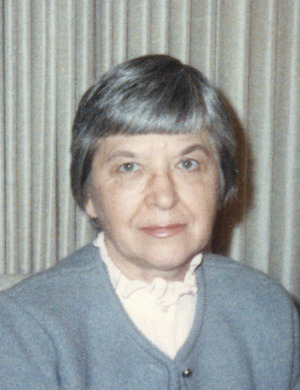Stephanie Kwolek facts for kids
Quick facts for kids
Stephanie Kwolek
|
|
|---|---|

Kwolek in 1986
|
|
| Born |
Stephanie Louise Kwolek
July 31, 1923 Pittsburgh, Pennsylvania, U.S.
|
| Died | June 18, 2014 (aged 90) Talleyville, Delaware, U.S.
|
| Education | Carnegie Mellon University |
| Known for | Invention of Kevlar |
| Awards |
|
| Scientific career | |
| Fields | Polymer chemistry |
Stephanie Louise Kwolek (July 31, 1923 – June 18, 2014) was a brilliant Polish-American chemist. She is most famous for inventing Kevlar, an incredibly strong material. Stephanie worked for the DuPont company for over 40 years.
Her amazing discovery earned her DuPont's Lavoisier Medal. This award is given for outstanding technical achievements. As of 2019, she was the only woman at DuPont to receive this special honor. In 1995, she became one of the few women added to the National Inventors Hall of Fame. Stephanie Kwolek won many awards for her work with polymer chemistry, including the National Medal of Technology.
Contents
Early Life and Education
Stephanie Kwolek was born in 1923 in New Kensington, near Pittsburgh. Her parents were immigrants from Poland. She had one sibling. Stephanie went to a small grade school where two different grades shared a classroom. She thought this was a good thing because it helped her learn faster.
Stephanie's father, John Kwolek, passed away when she was ten. He loved nature, and they spent many hours together exploring the woods. They would collect plants and watch animals, writing about them in a scrapbook. Stephanie said her father sparked her interest in science. Her mother, Nellie Kwolek, was a seamstress. Stephanie also liked fashion design, but her mother told her she was too much of a perfectionist for that career. So, Stephanie decided she wanted to become a doctor.
In 1946, Stephanie earned a Bachelor of Science degree in chemistry from Carnegie Mellon University. She still planned to go to medical school. She hoped to save enough money from a temporary job in chemistry to pay for her medical studies.
Working at DuPont
In 1946, Stephanie was offered a job at DuPont's facility in Buffalo, New York. She was interviewed by William Hale Charch, who would later become her mentor. During the interview, Stephanie asked if they could tell her quickly if she got the job. She had another job offer to consider. Dr. Charch then wrote her offer letter right away!
DuPont, a chemical company, was looking for a new fiber. They wanted something made from petroleum that would be lighter and stronger than steel. This new material was needed for things like radial tires. Many men were away fighting in World War II, so DuPont had job openings. The company had recently created nylon, which was very successful.
During the war, there was a great need for lightweight armor. Soldiers needed protection that was strong enough to stop bullets but light enough to wear. Steel was too heavy for body armor. Even for armored vehicles, steel could be pierced by special bullets.
Stephanie planned to work at DuPont only for a short time to save money for medical school. But she found the polymer research so interesting and challenging that she changed her mind. She decided to make chemistry her lifelong career.
Her research team moved to Wilmington, Delaware, in 1950. In 1959, she won an award from the American Chemical Society (ACS). This was the first of many awards. She wrote a paper called "The Nylon Rope Trick." It showed how to make nylon in a beaker at room temperature. This experiment is still used in classrooms today. Stephanie worked at DuPont for her entire career, which lasted over 40 years. She filed 28 patents during that time. Besides Kevlar, she also helped create products like Spandex (Lycra) and Nomex. After she retired in 1986, she continued to work as a consultant for DuPont. In 1995, she became the first woman to receive the company’s Lavoisier medal for her research.
Stephanie also worked on finding new ways to make polymers at lower temperatures. For example, nylon is usually made at very high temperatures (over 200 degrees Celsius). Her new methods used faster reactions at much lower temperatures (between 0 and 40 degrees Celsius). This allowed her to create polymers that could not be melted and only broke down at very high temperatures (above 400 degrees Celsius).
The Invention of Kevlar
Stephanie Kwolek is most famous for her work in the 1950s and 1960s with materials called aramids. These are a type of polymer that can be made into very strong, stiff, and flame-resistant fibers. Her supervisor, Paul W. Morgan, thought these aramids would make strong fibers. He also believed they would need to be made from a solution because they only melted at extremely high temperatures.
Stephanie found the right liquids and conditions to create these special polymers. She first helped develop Nomex, a flame-resistant fiber released by DuPont in 1961. Then, she worked on other aramids. She noticed that these new materials formed very neat, rod-like structures when they were in a liquid. These were the first "liquid crystal polymers" ever made. From these, she was able to spin fibers that were incredibly stiff and strong. This amazing new polymer, invented by Stephanie Kwolek, was named Kevlar.
In 1964, Stephanie's team started looking for a lightweight, strong fiber to replace steel in tires. They were worried about a possible gasoline shortage. The polymers she was working with usually needed to be melted at over 200 degrees Celsius. This made the fibers weaker. Her new technique allowed her to make these polymers at much lower temperatures, between 0 and 40 degrees Celsius.
She described one of her solutions in a speech:
The solution was unusually thin, cloudy, and looked like buttermilk. Regular polymer solutions are usually clear and thick, like molasses. My solution looked like it had tiny bits floating in it, but it could be filtered perfectly. This was a liquid crystalline solution, but I didn't know it at the time.
Usually, a cloudy solution like this would be thrown away. People thought it would clog the machine used to spin fibers. But Stephanie convinced a technician named Charles Smullen to test her solution. To her surprise, the new fiber did not break when nylon usually would. It was not just stronger than nylon; Kevlar was an astonishing five times stronger than steel by weight! Both her supervisor and the lab director quickly understood how important her discovery was. A new area of polymer chemistry began because of it. By 1971, modern Kevlar was ready. Stephanie also found that heating the fibers could make them even stronger. The tiny rod-shaped molecules in Kevlar line up perfectly, which gives it its incredible strength.
How Kevlar is Used
Stephanie Kwolek was not directly involved in finding uses for Kevlar. Once DuPont managers learned about her discovery, they put a whole team to work on it. Stephanie continued to research different types of Kevlar. She did not make money from DuPont's products because she signed over the Kevlar patent to the company.
Kevlar is used in over 200 different products today! You can find it in tennis rackets, skis, and parachute lines. It's used in boats, airplanes, ropes, and cables. Most importantly, it's used in bullet-proof vests for police and military. It's also in car tires, firefighter boots, hockey sticks, and gloves that resist cuts. Armored cars use it too.
Kevlar is even used in building materials to make things bomb-proof or to create safe rooms during hurricanes. It can also strengthen bridges. The week Stephanie Kwolek passed away, the one millionth bullet-resistant vest made with Kevlar was sold. Kevlar is also used to make strong cell phone cases, like the one on the Motorola Droid RAZR.
Kevlar has saved many lives as lightweight body armor. It protects undersea fiber optic cables that carry messages across oceans. It's used in super-strong ropes to hold up bridges. And you can find it in countless other items, from protective clothing for athletes to canoes, drumheads, and even frying pans!
Awards, Honors, and Legacy

For inventing Kevlar, Stephanie Kwolek received the DuPont company's Lavoisier Medal in 1995. The award recognized her as a "Persistent experimentalist and role model whose discovery of liquid crystalline polyamides led to Kevlar aramid fibers." When she died in 2014, she was still the only woman at DuPont to receive this honor. Her discovery brought billions of dollars to DuPont, but she did not directly benefit financially from it.
In 1980, Kwolek received the Chemical Pioneer Award. She also got an Award for Creative Invention from the American Chemical Society. In 1995, Stephanie Kwolek was added to the National Inventors Hall of Fame. The next year, in 1996, she received the National Medal of Technology. In 1997, she was given the Perkin Medal. In 2003, she was inducted into the National Women's Hall of Fame.
She also received special honorary degrees from several universities. These include Carnegie Mellon University (2001) and Worcester Polytechnic Institute (1981).
The Royal Society of Chemistry gives out a special 'Stephanie L Kwolek Award' every two years. This award honors scientists who make amazing contributions to materials chemistry outside the UK. Stephanie Kwolek is also featured as one of the Royal Society of Chemistry's 175 Faces of Chemistry.
Later Life
Stephanie Kwolek retired from DuPont in 1986. Later in her life, she worked as a consultant for DuPont. She also served on important science councils. During her 40 years as a research scientist, she filed and received many patents for her inventions.
She loved to help students learn chemistry. She also created and wrote about many science demonstrations for classrooms. One famous one is still used today: the Nylon Rope Trick.
Stephanie Kwolek passed away on June 18, 2014, at the age of 90.
See also
 In Spanish: Stephanie Kwolek para niños
In Spanish: Stephanie Kwolek para niños


